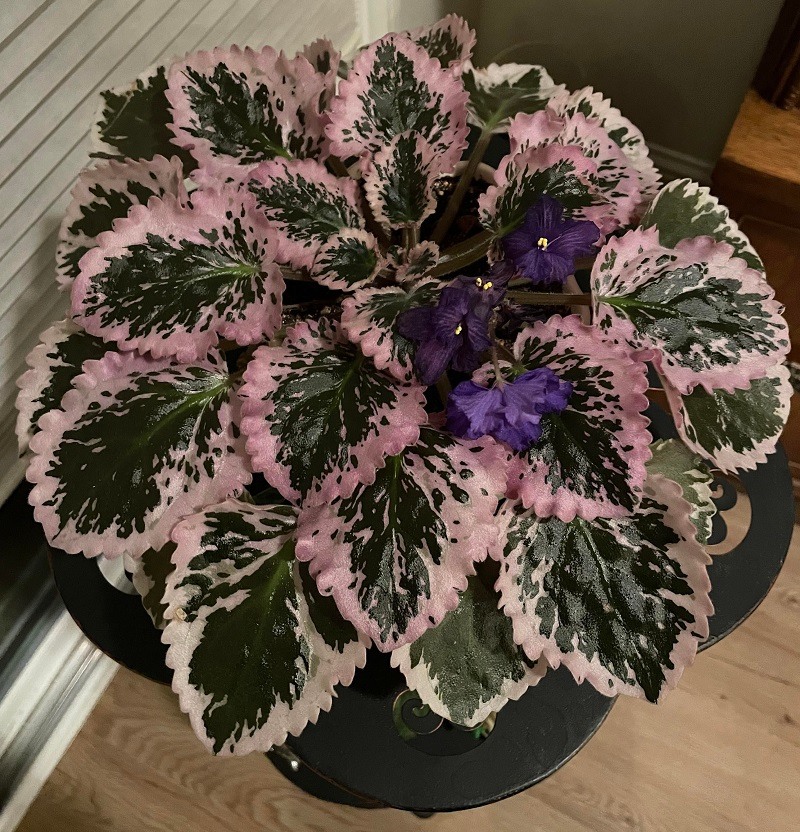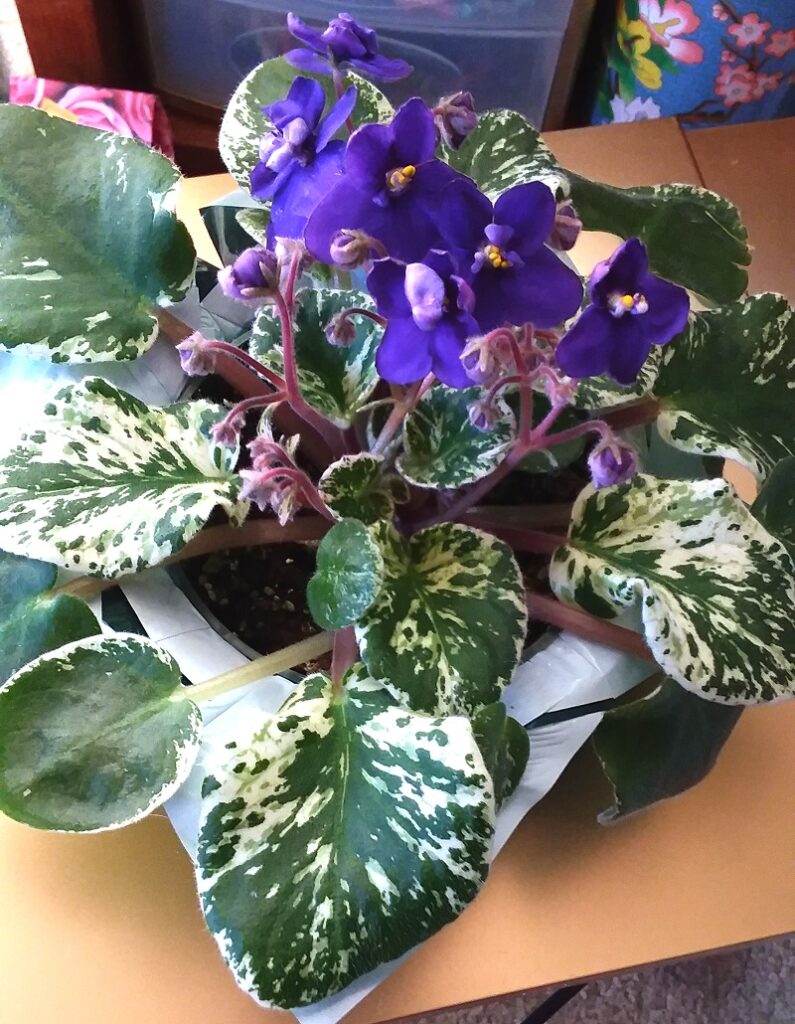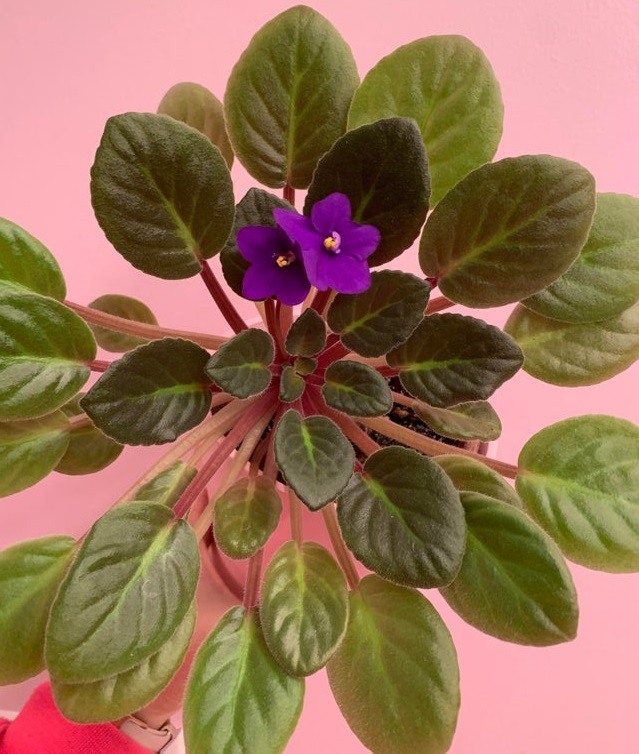I have been growing and caring for African violets since my childhood. The houseplant is available in multiple leaf forms and colors. One of my favorite features is that this plant can thrive indoors and outdoors without facing any challenges.
How to care for African violet involves the provision of bright indirect sunlight, well-draining potting mix, high humidity, relatively moist soil, and a temperature range of 70-80oF (21-27oC). Be sure to feed your African violet every week during spring and summer.
I wrote this African violet care guide to help you understand it. Remember African violet care indoor regime is super different from the outdoor counterpart. Continue reading to find out more about this magical indoor plant.

What Does African Violet Look Like?
African violet is a compact and low-growing flowering plant. The houseplant bloom comes in several shades like blue, violet, pink, lavender, red-violet, lavender-pink, white, and purple.
This indoor plant hails from the high-elevation tropical forest in Tanzania. The pretty flowers are the reason behind the name African violet.
The succulent foliages with fine hairs enable the plant to absorb moisture from the air. The variegated leaves add ornamental value due to their lasting impressions.
African violets can reach 2 to 6 inches tall and 3 inches wide. All varieties have flower clusters at the center surrounded by rosette-like layers of dark green leaves.
Some African varieties have flower clusters with semi-double or double petal layers, trailing growth habits, and bicolor flowers. The houseplant blooms several times a year.
African violets are non-toxic to pets and humans. But the houseplant can be problematic for allergy sufferers. Keep the plant away from pets and toddlers to avoid destruction.
African Violet Care Details
| Origin | Tropical forest in Tanzania |
| Scientific Name | Saintpaulia ssp |
| Common Name | African Violet |
| Maximum Height (Approx.) | 2 to 6 inches tall |
| Light Requirements | Bright indirect sunlight. Direct sunlight exposure will scorch the leaves. |
| Temperature Range | 65-75oF (18-24oC). Any temperature below 60oF will trigger dormancy. |
| Soil Requirements | Fertile and well-draining potting mix. Combine peat moss, vermiculite, and perlite. |
| Humidity Range | 60-70 %. High humidity allows African violet to thrive well. |
| Watering Requirements | Ensure the potting mix is relatively moist. Avoid overwatering and under-watering problems. |
| Fertilizer Application | Feed your houseplant once every month during spring and summer. |
| Pruning and Maintenance | Remove old or damaged leaves. |
| Propagation | Leaf-cutting, seeds, and division |
| Re-potting | Every 2-3 years due to root-bound issues. |
| Bloom | Flower clusters with different color shades. |
| Pests and Diseases | Pests: Thrips, mealybugs, and cyclamin mites. Diseases: Powderly mildew, rot, and blight. |
| Toxicity | Non-toxic to cats and dogs |
How to Care for African Violet Plant
Mastering how to grow and care for African violet is crucial. These techniques will help avoid common African violet problems in the long run. Below are proven indoor African violet care tips to consider:
African Violet Pots
All potted houseplants do best in pots with several drainage holes to eliminate excess water from the potting mix. African violets are no exception in this case.
Hole-less ceramic pots are an excellent option for those houseplant enthusiasts who can afford them. But I recommend inexpensive plastic containers with drainage holes at the bottom.
The appropriate drainage system is essential to avoid root rot problems. Other factors to consider when choosing a pot are ease of cleaning, size, and style.
Soil Requirements
African violets thrive in a fertile and well-draining potting mix. An inappropriate drainage system will result in waterlogging and soggy potting soil.
A damp environment increases root rot risks among African violets. The African violet leaves will drop off, and the plant will later die.
I recommend mixing equal parts of potting soil, peat moss, and perlite. Add compost to boost the potting mix fertility and foster healthy African violet growth.
Avoid commercial African violet soil mixes since they are too dense and heavy to enhance proper root growth. Do not expose the houseplant to standing water for an extended period.
Light Requirements
African violets do best in bright indirect sunlight. Direct sunlight exposure will scorch or burn the leaves and also cause African violet leaves to droop.
These houseplants require 10-14 hours of indirect sunlight and eight hours of darkness to facilitate blooming. I recommend putting the plant near the east or west-facing windowsills.
Grow lights are the other best alternatives to natural lighting. Ensure the grow light chosen emits red and blue spectrums. These spectrums will encourage blooming and photosynthesis.
However, growing African violets under artificial lighting for an extended period will result in leaf bleaching. I recommend sticking to natural sunlight for healthy plant growth.
Water Requirements
Watering African violets is a crucial element to master. These houseplants do best in potting soil with consistent and even moisture distribution.
Excess soil moisture due to overwatering and poor drainage system will cause root rot. The fungal condition will cause yellow African violet leaves.
I recommend creating drainage holes on the pot to eliminate the excess moisture. If there are signs of root rot, consider transplanting your African violet to another container.
Dry potting soil due to inconsistent watering habits will cause plant dehydration. The African violet drooping and leaves curling are signs of under-watering.
Soak the potting soil to rehydrate your favorite houseplant. Design a strict watering schedule to keep your African violet hydrated throughout the year.
The golden rule is to inspect the potting soil moisture content before watering the plant. It will help avoid overwatering and under-watering problems.
African violet varieties use more water during spring and summer to support vegetative growth. Be sure to water the houseplant every week to meet the high demand.
Besides that, reduce the watering frequency during winter since the indoor plant will be experiencing dormancy. It is the phase where all houseplants underutilize water and nutrients.
Remember to use distilled water or rainwater for your African violet. Tap water contains minerals that will ruin your houseplant’s health.
Humidity Requirements
African violets hail from the Tanzanian tropical rainforest, where humidity is high. The environmental condition keeps this houseplant happy and healthy throughout the year.
Every houseplant enthusiast needs to replicate the tropical rainforest conditions at home. Ensure the indoor African violet gets at least 70% humidity level.
I recommend using the bottom-up watering system to keep the air around the plant moist. Another excellent option is to use an electric humidifier to boost indoor humidity levels.
Do not mist African violet leaves since it increases the leaf spot risks. The fungal infection will result in brown spots on the leaves.
Keeping African violets in dishes or trays of pebbles will also promote high humidity. Ensure the indoor space has adequate ventilation when humidity is high to avoid pest infestations.
African violet leaves curling and drooping are indicators of low humidity. If the condition persists, your African violet will wilt and die.
Temperature Requirements
African violets prefer a temperature range of 65 to 75oF (18 to 24oC). These houseplants are comfortable under indoor temperature that is pleasant to humans.
Avoid exposing your African violets to extreme temperature variations. Both cold and hot temperatures will make your favorite plant suffer.
Cold temperatures will make your African violet stop blooming and experience slow growth. Hot temperatures will facilitate excess water loss and cause plant dehydration.
I recommend keeping your indoor plant away from cold and hot drafts. It will facilitate healthy foliages development, flowering, and a faster growth rate.

African Violet Fertilizer Requirements
African violets are light-feeder tropical plants when compared to others. But fertilizer nutrients play a crucial role in its vegetative growth and wellness.
Feed your tropical plant with liquid African violet fertilizer rich in phosphorus every four to six weeks during spring and summer. Be sure to dilute the fertilizer to avoid soil toxicity.
Besides that, flush the potting soil every three months to remove accumulated fertilizer salts. I recommend watering your houseplant more frequently to avoid dehydration.
Too much fertilizer salts will cause African violet leaves to turn brown and wilting. Nutritional deficiency will result in African violet leaves turning yellow and pale.
It would be ideal to read my article on how to make homemade fertilizer for houseplants. The tips will help you avoid issues related to underfeeding or overfeeding.
Pruning and Maintenance
African violets are non-invasive houseplants. Grooming and maintaining this tropical plant is the easiest regardless of an individual experience.
I recommend cutting the damaged or old leaves with a sharp and sterilized blade. It helps the plant to stay compact and look beautiful.
Pinch the flowers to help the houseplant conserve energy. But these flowers usually brighten up your space due to their vibrant and striking colors.
African Violet Propagation
Leaf cuttings and offset division are the essential methods for propagating African violet plants at home. Always undertake African violet propagation during springtime due to active growth.
Adult plants produce small plantlets or shoots from the sides. Remove these offsets and pot them separately. Removing these offsets also encourages the parent plant to bloom.
Leaf-cutting is another preferred method for propagating African violets. Pick a healthy and middle-aged leaf from the middle of the plant.
Use a sharp and sterilized blade to cut the leaf leaving 1.5 inches from the stem. Stick the leaf stem in a moist potting mix. Ensure the potting mix lack soil to avoid fungus from infecting the leaf.
It will take six weeks for tiny plantlets to appear at the leaf base. Allow them to develop four leaves and separate them. Pot these plantlets independently in the potting soil.
African Violet Re-potting
African violets are less vulnerable to root-bound issues. I always recommend re-potting the houseplant due to overwatering and over-fertilization.
If you notice stunted growth and roots pooping through the drainage holes, re-potting your houseplant will be necessary. Use a pot slightly larger than the previous one.
Springtime is the best period for the re-pot African violet. It is the season when the houseplant experiences vegetative growth and can acclimate to the new environment faster.
African violet leaves falling or dropping is a common phenomenon after re-potting. Do not freak out, as the issue will diminish after acclimation.
African Violet Problems and Solutions
Pests
Mealybugs, thrips, and cyclamin mites are the pests that attack African violet plants. These sap-sucking creatures occur due to high humidity and poor ventilation.
I recommend using horticultural soap or neem oil to eliminate pests from the houseplant. Also, remember to isolate the plant to avoid spreading these insects to other houseplants.
Diseases
African violets are less vulnerable to common plant diseases. But this does not imply that the houseplant is invincible to these diseases.
Root rot is the leading plant condition that affects African violets. Overwatering and poor drainage is the reason behind the root rot problem.
Re-potting the plant asap after confirmation of root-rot will help save it. Remember to trim the brown patches with a sterilized blade and re-pot in a fresh potting mix and container.
African violet leaf blight is due to misting the houseplant leaves. Poor ventilation will trigger fungal growth and encourage the formation of yellow spots on African violet leaves.
Avoid misting your houseplant when humidity is low. Leaf wetting will also encourage bacterial growth and cause brown spots on African violet leaves.
African Violet Care FAQs
Is African Violet Toxic to Cats and Dogs?
African violets are non-toxic to curious cats and dogs (Source: Susan Camp). I recommend keeping your houseplant away from pets to avoid destruction.
Why Is My African Violet Flowers Dying?
Nutritional deficiency, low-lighting conditions, and lack of water are the reasons for African violet flowers dying. Investigate your houseplant and identify the exact cause before fixing it.
How Do I Get My African Violet to Bloom Again?
Feed your houseplant with a fertilizer rich in phosphorous and provide indirect sunlight. Be sure to water your plant more often to encourage flower production.

Final Word
Growing and caring for the African violet plant is a no-brainer task. The houseplant is robust and can tolerate various growing conditions without becoming fussy.
African violet care involves the provision of bright indirect sunlight, room temperature, high humidity, proper ventilation, moderate soil moisture, and regular pruning.
I hope this African violet care sheet was helpful. Kindly share this article with your friends or families in your community. Feel free also to share your experience in the comment section.
You May Also Like: Why Do My African Violet Leaves Have Spots?
